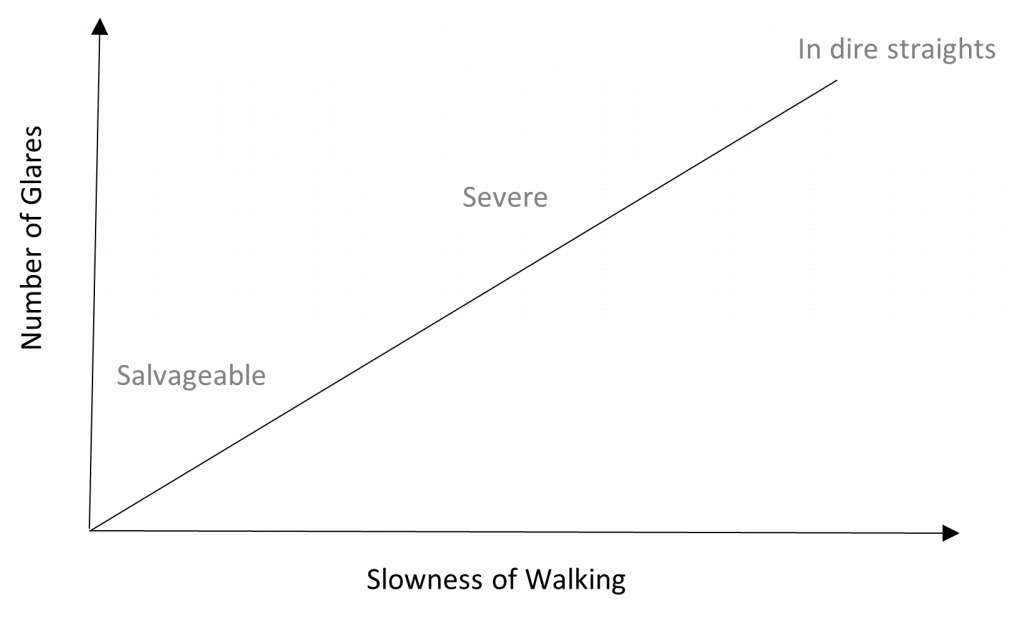Often tutted at by speedy over-takers on your pitiful stroll? Ashamed and tired of being a pest to society? Just follow our very simple guide that’ll propel you from a halt to a Bolt in no time at all. Plus, what better time to find a cure than now; local lockdown boasts ample time, ample space and, most importantly, minimal witnesses.
Step 1: Admitting there is a problem
Perhaps one of the hardest steps to overcoming your slowness is acceptance. After years of taunting, jibes and denial, by this point you’ll have quite the defence system in place. However, if you truly want help, and sincerely want to change, then you need to face up to reality. And remember, we’re not here to judge, we’re here to help.
Step 2: Evaluate the problem
An imperative step to rehabilitation is evaluation. Please refer to our chart below to determine the severity of your situation:

Image: Anna Stringer
Step 3: Devise a training schedule
Becoming Speedy Gonzales does not happen overnight. For those lacking in the haste department, it takes time, dedication and effort, but fear not: putting aside just five hours a week to improving your walking has been scientifically proven to increase your speed. Past recoverees have suggested devising a training schedule to help keep up with your weekly exercises.
Step 4: Join a support group
Durham itself has a variety of support groups for slow walkers, where you can go and chat in a judgement-free zone and they’re a perfect place to meet others such as yourselves and share stories. Meetings are on Wednesdays from 7-9pm but don’t usually start until 8pm (we often have quite a few latecomers).
Step 5: Interval training
If it’s good enough for world-class athletes, then it’s good enough for you. One major weakness of slow walkers is endurance. While you might be able to get up to speed, can you sustain it? No, didn’t think so. Next time you’re out (God help us all), try walking at an increased pace for 30 seconds and then more slowly for 60. As you become more advanced, you’ll be able to shorten these intervals, and before you know it, you’ll be speedier than Serena.
Step 6: Ankle weights
While ankle weights may initially seem counter-intuitive, they will no doubt speed up your recovery process. Training with the weights will strengthen your leg muscles so that when you walk without them, you’ll find yourself a much faster slowpoke.
Step 7: Positive reinforcement
Positive reinforcement is most certainly the key to your transformation; whether this entails recruiting a supportive fan base, or even treating yourself to the occasional 3 minutes of slow walking (we’ll allow it), be sure to factor in some sort of reward for yourself.
Step 8: Apologising
After recovery, it is time to make amends to friends and family. For those who cannot yet come to face to face with their family, we’d recommend sending a letter explaining your recovery process and the impact it’s had – not only on your own life – but on the lives of other pedestrians. It might take a while, but we’re sure they’ll find it in their hearts to forgive you.
Step 9: Invest in warning lights
While we have full confidence in our recovery plan, it is an unfortunate truth that not everybody can be cured. If, after following all of the above steps, your walking is still sub-par then we’d suggest investing in some high visibility warning lights, so that the average walker can anticipate and prepare for your hindrance. Better yet, stick to the inside pavement, or get yourself a pair of Heely’s.
Step 10: Impart your new-found knowledge
And lastly, if you know others in need, send them this way! Even just a few gentle words of encouragement can go a long way and sharing your story can prompt others to change their lives too.
Featured image: Keith Ellwood on Flickr.
